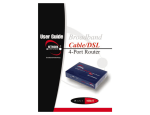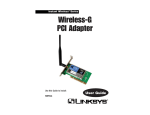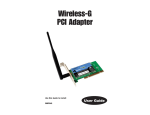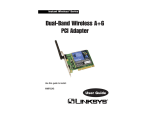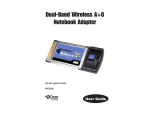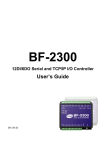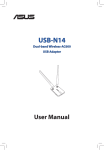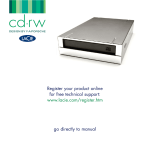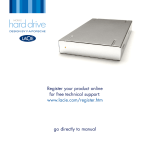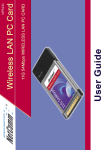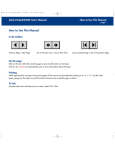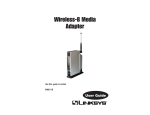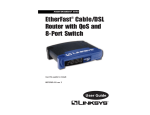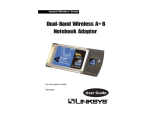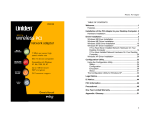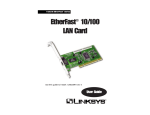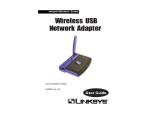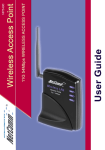Download WRT54G user guide.qxd
Transcript
Instant Wireless® Series Wireless-G Broadband Router Use this guide to install: WRT54G User Guide Instant Wireless® Series Auto-negotiate - To automatically determine the correct settings. The term is often used with communications and networking. For example, Ethernet 10/100 cards, hubs, and switches can determine the highest speed of the node they are connected to and adjust their transmission rate accordingly. Backbone – The part of a network that connects most of the systems and networks together and handles the most data. Bandwidth - The transmission capacity of a given facility, in terms of how much data the facility can transmit in a fixed amount of time; expressed in bits per second (bps). Beacon Interval - A beacon is a packet broadcast by the Access Point to keep the network synchronized. A beacon includes the wireless LAN service area, the AP address, the Broadcast destination addresses, a time stamp, Delivery Traffic Indicator Maps, and the Traffic Indicator Message (TIM). Bit – A binary digit. The value—0 or 1—used in the binary numbering system. Also, the smallest form of data. Boot – To cause the computer to start executing instructions. Personal computers contain built-in instructions in a ROM chip that are automatically executed on startup. These instructions search for the operating system, load it, and pass control to it. Bottleneck – A traffic slowdown that results when too many network nodes try to access a single node, often a server node, at once. Bridge - A device that interconnects different networks together. Broadband - A data-transmission scheme in which multiple signals share the bandwidth of a medium. This allows the transmission of voice, data, and video signals over a single medium. Cable television uses broadband techniques to deliver dozens of channels over one cable. Browser - A browser is an application program that provides a way to look at and interact with all the information on the World Wide Web or PC. The word “browser” seems to have originated prior to the Web as a generic term for user interfaces that let you browse text files online. Buffer - A buffer is a shared or assigned memory area used by hardware devices or program processes that operate at different speeds or with different 94 Wireless-G Broadband Router sets of priorities. The buffer allows each device or process to operate without being held up by the other. In order for a buffer to be effective, the size of the buffer and the algorithms for moving data into and out of the buffer need to be considered by the buffer designer. Like a cache, a buffer is a “midpoint holding place” but exists not so much to accelerate the speed of an activity as to support the coordination of separate activities. Cable Modem - A device that connects a computer to the cable television network, which in turn connects to the Internet. Once connected, cable modem users have a continuous connection to the Internet. Cable modems feature asymmetric transfer rates: around 36 Mbps downstream (from the Internet to the computer), and from 200 Kbps to 2 Mbps upstream (from the computer to the Internet). CAT 5 - ANSI/EIA (American National Standards Institute/Electronic Industries Association) Standard 568 is one of several standards that specify “categories” (the singular is commonly referred to as “CAT”) of twisted pair cabling systems (wires, junctions, and connectors) in terms of the data rates that they can sustain. CAT 5 cable has a maximum throughput of 100 Mbps and is usually utilized for 100BaseTX networks. CPU (Central Processing Unit) - The computing part of the computer. Also called the “processor,” it is made up of the control unit and ALU. CSMA/CD (Carrier Sense Multiple Access/Collision Detection) - The LAN access method used in Ethernet. When a device wants to gain access to the network, it checks to see if the network is quiet (senses the carrier). If it is not, it waits a random amount of time before retrying. If the network is quiet and two devices access the line at exactly the same time, their signals collide. When the collision is detected, they both back off and each waits a random amount of time before retrying. CTS (Clear To Send) - An RS-232 signal sent from the receiving station to the transmitting station that indicates it is ready to accept data. Database - A database is a collection of data that is organized so that its contents can easily be accessed, managed, and updated. Data Packet - One frame in a packet-switched message. Most data communications is based on dividing the transmitted message into packets. For example, an Ethernet packet can be from 64 to 1518 bytes in length. Default Gateway - The routing device used to forward all traffic that is not addressed to a station within the local subnet. 95 Instant Wireless® Series DDNS (Dynamic Domain Name System) - Allows a network device with a dynamic Internet IP address to have a fixed host and domain name, such as myhostname.mydomainname.com. It is useful when you are hosting your own website, FTP server, or other server behind a router, so people can find your site no matter how often the Internet IP address changes. Using DDNS requires registering with a DDNS service provider on the Internet. DHCP (Dynamic Host Configuration Protocol) - A protocol that lets network administrators centrally manage and automate the assignment of Internet Protocol (IP) addresses in an organization's network. Using the Internet’s set of protocol (TCP/IP), each machine that can connect to the Internet needs a unique IP address. When an organization sets up its computer users with a connection to the Internet, an IP address must be assigned to each machine. Without DHCP, the IP address must be entered manually at each computer and, if computers move to another location in another part of the network, a new IP address must be entered. DHCP lets a network administrator supervise and distribute IP addresses from a central point and automatically sends a new IP address when a computer is plugged into a different place in the network. DHCP uses the concept of a “lease” or amount of time that a given IP address will be valid for a computer. The lease time can vary depending on how long a user is likely to require the Internet connection at a particular location. It’s especially useful in education and other environments where users change frequently. Using very short leases, DHCP can dynamically reconfigure networks in which there are more computers than there are available IP addresses. DHCP supports static addresses for computers containing Web servers that need a permanent IP address. DMZ - (DeMilitarized Zone) allows one IP address (or computer) to be exposed to the Internet. Some applications require multiple TCP/IP ports to be open. It is recommended that you set your computer with a static IP address if you want to use DMZ Hosting. DNS - The Domain Name System (DNS) is the way that Internet domain names are located and translated into Internet Protocol (IP) addresses. A domain name is a meaningful and easy-to-remember “handle” for an Internet address. Domain - A subnetwork comprised of a group of clients and servers under the control of one security database. Dividing LANs into domains improves performance and security. 96 Wireless-G Broadband Router Download - To receive a file transmitted over a network. In a communications session, download means receive, and upload means transmit. Driver - A workstation or server software module that provides an interface between a network interface card and the upper-layer protocol software running in the computer; it is designed for a specific NIC, and is installed during the initial installation of a network-compatible client or server operating system. DSSS (Direct-Sequence Spread Spectrum) - DSSS generates a redundant bit pattern for all transmitted data. This bit pattern is called a chip (or chipping code). Even if one or more bits in the chip are damaged during transmission, statistical techniques embedded in the receiver can recover the original data without the need for retransmission. To an unintended receiver, DSSS appears as low power wideband noise and is rejected (ignored) by most narrowband receivers. However, to an intended receiver (i.e. another wireless LAN endpoint), the DSSS signal is recognized as the only valid signal, and interference is inherently rejected (ignored). DTIM (Delivery Traffic Indication Message) - A DTIM field is a countdown field informing clients of the next window for listening to broadcast and multicast messages. When the AP has buffered broadcast or multicast messages for associated clients, it sends the next DTIM with a DTIM Interval value. AP Clients hear the beacons and awaken to receive the broadcast and multicast messages. Dynamic IP Address - An IP address that is automatically assigned to a client station in a TCP/IP network, typically by a DHCP server. Network devices that serve multiple users, such as servers and printers, are usually assigned static IP addresses. Dynamic Routing - The ability for a router to forward data via a different route based on the current conditions of the communications circuits. For example, it can adjust for overloaded traffic or failing lines and is much more flexible than static routing, which uses a fixed forwarding path. Encryption - A security method that applies a specific algorithm to data in order to alter the data’s appearance and prevent other devices from reading the information. Ethernet - IEEE standard network protocol that specifies how data is placed on and retrieved from a common transmission medium. Has a transfer rate of 10 Mbps. Forms the underlying transport vehicle used by several upper-level protocols, including TCP/IP and XNS. 97 Instant Wireless® Series Fast Ethernet - A 100 Mbps technology based on the 10Base-T Ethernet CSMA/CD network access method. Full Duplex - The ability of a device or line to transmit data simultaneously in both directions. FHSS (Frequency Hopping Spread Spectrum) - FHSS continuously changes (hops) the carrier frequency of a conventional carrier several times per second according to a pseudo-random set of channels. Because a fixed frequency is not used, and only the transmitter and receiver know the hop patterns, interception of FHSS is extremely difficult. Gateway – A device that interconnects networks with different, incompatible communications protocols. Half Duplex - Data transmission that can occur in two directions over a single line, but only one direction at a time. Firewall - A firewall is a set of related programs, located at a network gateway server, that protects the resources of a network from users from other networks. (The term also implies the security policy that is used with the programs.) An enterprise with an intranet that allows its workers access to the wider Internet installs a firewall to prevent outsiders from accessing its own private data resources and for controlling what outside resources to which its own users have access. Basically, a firewall, working closely with a router, examines each network packet to determine whether to forward it toward its destination. Firmware - Code that is written onto read-only memory (ROM) or programmable read-only memory (PROM). Once firmware has been written onto the ROM or PROM, it is retained even when the device is turned off. Fragmentation - Breaking a packet into smaller units when transmitting over a network medium that cannot support the original size of the packet. FTP (File Transfer Protocol) - A protocol used to transfer files over a TCP/IP network (Internet, UNIX, etc.). For example, after developing the HTML pages for a website on a local machine, they are typically uploaded to the Web server using FTP. FTP includes functions to log onto the network, list directories, and copy files. It can also convert between the ASCII and EBCDIC character codes. FTP operations can be performed by typing commands at a command prompt or via an FTP utility running under a graphical interface such as Windows. FTP transfers can also be initiated from within a Web browser by entering the URL preceded with ftp://. Unlike e-mail programs in which graphics and program files have to be “attached,” FTP is designed to handle binary files directly and does not add the overhead of encoding and decoding the data. 98 Wireless-G Broadband Router Hardware - Hardware is the physical aspect of computers, telecommunications, and other information technology devices. The term arose as a way to distinguish the “box” and the electronic circuitry and components of a computer from the program you put in it to make it do things. The program came to be known as the software. Hub - The device that serves as the central location for attaching wires from workstations. Can be passive, where there is no amplification of the signals; or active, where the hubs are used like repeaters to provide an extension of the cable that connects to a workstation. HTTP (HyperText Transport Protocol) - The communications protocol used to connect to servers on the World Wide Web. Its primary function is to establish a connection with a Web server and transmit HTML pages to the client browser. IEEE - The Institute of Electrical and Electronics Engineers. The IEEE describes itself as “the world's largest technical professional society—promoting the development and application of electrotechnology and allied sciences for the benefit of humanity, the advancement of the profession, and the wellbeing of our members.” The IEEE fosters the development of standards that often become national and international standards. The organization publishes a number of journals, has many local chapters, and has several large societies in special areas, such as the IEEE Computer Society. Infrastructure Network - An infrastructure network is a group of computers or other devices, each with a wireless adapter, connected as an 802.11 wireless LAN. In infrastructure mode, the wireless devices communicate with each other and to a wired network by first going through an access point. An infrastructure wireless network connected to a wired network is referred to as a Basic Service Set (BSS). A set of two or more BSS in a single network is referred to as an Extended Service Set (ESS). Infrastructure mode is useful at 99 Instant Wireless® Series a corporation scale, or when it is necessary to connect the wired and wireless networks. resources of a single processor or server within a small geographic area (for example, within an office building). IP Address - In the most widely installed level of the Internet Protocol (IP) today, an IP address is a 32-binary digit number that identifies each sender or receiver of information that is sent in packets across the Internet. When you request an HTML page or send e-mail, the Internet Protocol part of TCP/IP includes your IP address in the message (actually, in each of the packets if more than one is required) and sends it to the IP address that is obtained by looking up the domain name in the Uniform Resource Locator you requested or in the e-mail address you're sending a note to. At the other end, the recipient can see the IP address of the Web page requestor or the e-mail sender and can respond by sending another message using the IP address it received. Latency - The time delay between when the first bit of a packet is received and the last bit is forwarded. IPCONFIG - A utility that provides for querying, defining and managing IP addresses within a network. A commonly used utility, under Windows NT and 2000, for configuring networks with static IP addresses. IPSec (Internet Protocol Security) - A suite of protocols used to implement secure exchange of packets at the IP layer. IPSec supports two basic modes: Transport and Tunnel. Transport encrypts the payload of each packet, leaving the header untouched, while Tunnel mode encrypts both the header and the payload and is therefore more secure. IPSec must be supported on both transmitter and receiver and must share a public key. Tunnel mode is widely deployed in VPNs (Virtual Private Networks). IRQ (Interrupt ReQuest) - A hardware interrupt on a PC. There are 16 IRQ lines used to signal the CPU that a peripheral event has started or terminated. Except for PCI devices, two devices cannot use the same line. ISM band - The FCC and their counterparts outside of the U.S. have set aside bandwidth for unlicensed use in the ISM (Industrial, Scientific and Medical) band. Spectrum in the vicinity of 2.4 GHz, in particular, is being made available worldwide. This presents a truly revolutionary opportunity to place convenient high-speed wireless capabilities in the hands of users around the globe. ISP - An ISP (Internet service provider) is a company that provides individuals and companies access to the Internet and other related services such as website building and virtual hosting. LAN - A local area network (LAN) is a group of computers and associated devices that share a common communications line and typically share the 100 Wireless-G Broadband Router MAC Address - The MAC (Media Access Control) address is a unique number assigned by the manufacturer to any Ethernet networking device, such as a network adapter, that allows the network to identify it at the hardware level. Mbps (MegaBits Per Second) - One million bits per second; unit of measurement for data transmission. MD5 - A type of one-way authentication method that uses passwords. MD5 authentication is not as secure as the EAP-TLS or EAP/TTLS authentication methods. MD5 authentication does not support dynamic WEP key management. MDI (Medium Dependent Interface) - On a network hub or switch, a MDI port, also known as an uplink port, connects to another hub or switch using a straight-through cable. To connect a MDI port to a computer, use a crossover cable. MDIX (Medium Dependent Interface Crossed) - On a network hub or switch, a MDIX port connects to a computer using a straight-through cable. To connect a MDIX port to another hub or switch, use a crossover cable. mIRC - mIRC runs under Windows and provides a graphical interface for logging onto IRC servers and listing, joining, and leaving channels. Motherboard - A motherboard is the physical arrangement in a computer that contains the computer’s basic circuitry and components. Multicasting - Sending data to a group of nodes instead of a single destination. NAT - NAT (Network Address Translation) is the translation of an Internet Protocol address (IP address) used within one network to a different IP address known within another network. One network is designated the inside network and the other is the outside. NetBEUI (NetBIOS Extended User Interface) - The transport layer for NetBIOS. NetBIOS and NetBEUI were originally part of a single protocol suite that was later separated. NetBIOS sessions can be transported over NetBEUI, TCP/IP, and IPX/SPX protocols. 101 Instant Wireless® Series NetBIOS - The native networking protocol in DOS and Windows networks. Although originally combined with its transport layer protocol (NetBEUI), NetBIOS today provides a programming interface for applications at the session layer (layer 5). NetBIOS can ride over NetBEUI, its native transport, which is not routable, or over TCP/IP and IPX/SPX, which are routable protocols. NetBIOS computers are identified by a unique 15-character name, and Windows machines (NetBIOS machines) periodically broadcast their names over the network so that Network Neighborhood can catalog them. For TCP/IP networks, NetBIOS names are turned into IP addresses via manual configuration in an LMHOSTS file or a WINS server. There are two NetBIOS modes. The Datagram mode is the fastest mode, but does not guarantee delivery. It uses a self-contained packet with send and receive name, usually limited to 512 bytes. If the recipient device is not listening for messages, the datagram is lost. The Session mode establishes a connection until broken. It guarantees delivery of messages up to 64KB long. Network - A system that transmits any combination of voice, video, and/or data between users. Network Mask - Also known as the “Subnet Mask.” NIC (Network Interface Card) - A board installed in a computer system, usually a PC, to provide network communication capabilities to and from that computer system. Also called an adapter. Node - A network junction or connection point, typically a computer or work station. Notebook (PC) - A notebook computer is a battery-powered personal computer generally smaller than a briefcase that can easily be transported and conveniently used in temporary spaces such as on airplanes, in libraries, at temporary offices, and at meetings. A notebook computer, sometimes called a laptop computer, typically weighs less than five pounds and is three inches or less in thickness. OFDM - Developed for wireless applications, Orthogonal Frequency Division Multiplexing (OFDM) technology offers superior performance-increased data rates and more reliable transmissions-than previous technologies, such as 102 Wireless-G Broadband Router DSSS. OFDM is a scheme in which numerous signals of different frequencies are combined to form a single signal for transmission on the medium. OFDM works by breaking one high-speed data stream into a number of lowerspeed data streams, which are then transmitted in parallel. Each lower speed stream is used to modulate a subcarrier. Essentially, this creates a multi-carrier transmission by dividing a wide frequency band or channel into a number of narrower frequency bands or sub-channels. OFDM is also used for other applications, including powerline networking. Packet - A unit of data routed between an origin and a destination in a network. Packet Filtering - Discarding unwanted network traffic based on its originating address or range of addresses or its type (e-mail, file transfer, etc.). Partitioning - To divide a resource or application into smaller pieces. Passphrase - Used much like a password, a passphrase simplifies the WEP encryption process by automatically generating the WEP encryption keys for Linksys products. PC Card - A credit-card sized removable module that contains memory, I/O, or a hard disk. PCI (Peripheral Component Interconnect) - A peripheral bus commonly used in PCs, Macintoshes and workstations. It was designed primarily by Intel and first appeared on PCs in late 1993. PCI provides a high-speed data path between the CPU and peripheral devices (video, disk, network, etc.). There are typically three or four PCI slots on the motherboard. In a Pentium PC, there is generally a mix of PCI and ISA slots or PCI and EISA slots. Early on, the PCI bus was known as a “local bus.” PCI provides “plug-and-play” capability, automatically configuring the PCI cards at startup. When PCI is used with the ISA bus, the only thing that is generally required is to indicate in the CMOS memory which IRQs are already in use by ISA cards. PCI takes care of the rest. PCI allows IRQs to be shared, which helps to solve the problem of limited IRQs available on a PC. For example, if there were only one IRQ left over after ISA devices were given their required IRQs, all PCI devices could share it. In a PCIonly machine, there cannot be insufficient IRQs, as all can be shared. 103 Instant Wireless® Series PCMCIA - The PCMCIA (Personal Computer Memory Card International Association) is an industry group organized in 1989 to promote standards for a credit card-size memory or I/O device that would fit into a personal computer, usually a notebook or laptop computer. Ping (Packet INternet Groper) - An Internet utility used to determine whether a particular IP address is online. It is used to test and debug a network by sending out a packet and waiting for a response. Plug-and-Play - The ability of a computer system to configure expansion boards and other devices automatically without requiring the user to turn off the system during installation. service” for carrying PPP (a tunneling service is any network service enabled by tunneling protocols such as PPTP, L2F, L2TP, and IPSEC tunnel mode). One example of a tunneling service is secure access from a remote small office network to a headquarters corporate intranet via a Virtual Private Network (VPN) that traverses the Internet. However, tunneling services are not restricted to corporate environments and may also be used for personal (i.e., non-business) applications. RIP (Routing Information Protocol) - A simple routing protocol that is part of the TCP/IP protocol suite. It determines a route based on the smallest hop count between source and destination. RIP is a distance vector protocol that routinely broadcasts routing information to its neighboring routers. POP3 (Post Office Protocol 3) - A standard mail server commonly used on the Internet. It provides a message store that holds incoming e-mail until users log on and download it. POP3 is a simple system with little selectivity. All pending messages and attachments are downloaded at the same time. POP3 uses the SMTP messaging protocol. RJ-11 (Registered Jack-11) - A telephone connector that holds up to six wires. The RJ-11 is the common connector used to plug a telephone into a wall. Port - A pathway into and out of the computer or a network device such as a switch or router. For example, the serial and parallel ports on a personal computer are external sockets for plugging in communications lines, modems, and printers. Roaming - In an infrastructure mode wireless network, this refers to the ability to move out of one access point's range and into another and transparently reassociate and reauthenticate to the new access point. This reassociation and reauthentication should occur without user intervention and ideally without interruption to network connectivity. A typical scenario would be a location with multiple access points, where users can physically relocate from one area to another and easily maintain connectivity. Port Mirroring - Port mirroring, also known as a roving analysis port, is a method of monitoring network traffic that forwards a copy of each incoming and outgoing packet from one port of a network switch to another port where the packet can be studied. A network administrator uses port mirroring as a diagnostic tool or debugging feature, especially when fending off an attack. It enables the administrator to keep close track of switch performance and alter it if necessary. Port mirroring can be managed locally or remotely. PPPoE (Point to Point Protocol over Ethernet) - PPPoE is a method for the encapsulation of PPP packets over Ethernet frames from the user to the ISP over the Internet. One reason PPPoE is preferred by ISPs is because it provides authentication (username and password) in addition to data transport. A PPPoE session can be initiated by either a client application residing on a PC, or by client firmware residing on a modem or router. PPTP (Point-to-Point Tunneling Protocol) - A protocol which allows the Point to Point Protocol (PPP) to be tunneled through an IP network. PPTP does not specify any changes to the PPP protocol but rather describes a “tunneling 104 Wireless-G Broadband Router RJ-45 - A connector similar to a telephone connector that holds up to eight wires, used for connecting Ethernet devices. Router - Protocol-dependent device that connects subnetworks together. Routers are useful in breaking down a very large network into smaller subnetworks; they introduce longer delays and typically have much lower throughput rates than bridges. RTS (Request To Send) - An RS-232 signal sent from the transmitting station to the receiving station requesting permission to transmit. Server - Any computer whose function in a network is to provide user access to files, printing, communications, and other services. SMTP (Simple Mail Transfer Protocol) - The standard e-mail protocol on the Internet. It is a TCP/IP protocol that defines the message format and the message transfer agent (MTA), which stores and forwards the mail. 105 Instant Wireless® Series SNMP (Simple Network Management Protocol) - A widely used network monitoring and control protocol. Data is passed from SNMP agents, which are hardware and/or software processes reporting activity in each network device (hub, router, bridge, etc.) to the workstation console used to oversee the network. The agents return information contained in a MIB (Management Information Base), which is a data structure that defines what is obtainable from the device and what can be controlled (turned off, on, etc.). Software - Instructions for the computer. A series of instructions that performs a particular task is called a “program.” The two major categories of software are “system software” and “application software.” System software is made up of control programs such as the operating system and database management system (DBMS). Application software is any program that processes data for the user. A common misconception is that software is data. It is not. Software tells the hardware how to process the data. SOHO (Small Office/Home Office) - Market segment of professionals who work at home or in small offices. Spread Spectrum - Spread Spectrum technology is a wideband radio frequency technique developed by the military for use in reliable, secure, mission-critical communications systems. It is designed to trade off bandwidth efficiency for reliability, integrity, and security. In other words, more bandwidth is consumed than in the case of narrowband transmission, but the trade off produces a signal that is, in effect, louder and thus easier to detect, provided that the receiver knows the parameters of the spread-spectrum signal being broadcast. If a receiver is not tuned to the right frequency, a spread-spectrum signal looks like background noise. There are two main alternatives, Direct Sequence Spread Spectrum (DSSS) and Frequency Hopping Spread Spectrum (FHSS). Static IP Address - A permanent IP address that is assigned to a node in a TCP/IP network. Static Routing - Forwarding data in a network via a fixed path. Static routing cannot adjust to changing line conditions as can dynamic routing. Storage - The semi-permanent or permanent holding place for digital data. STP (Shielded Twisted Pair) - Telephone wire that is wrapped in a metal sheath to eliminate external interference. 106 Wireless-G Broadband Router Subnet Mask - The method used for splitting IP networks into a series of subgroups, or subnets. The mask is a binary pattern that is matched up with the IP address to turn part of the host ID address field into a field for subnets. Swapping - Replacing one segment of a program in memory with another and restoring it back to the original when required. Switch – 1. A data switch connects computing devices to host computers, allowing a large number of devices to share a limited number of ports. 2. A device for making, breaking, or changing the connections in an electrical circuit. TCP (Transmission Control Protocol) - A method (protocol) used along with the IP (Internet Protocol) to send data in the form of message units (datagram) between network devices over a LAN or WAN. While IP takes care of handling the actual delivery of the data (routing), TCP takes care of keeping track of the individual units of data (called packets) that a message is divided into for efficient delivery over the network. TCP is known as a “connection oriented” protocol due to requiring the receiver of a packet to return an acknowledgment of receipt to the sender of the packet resulting in transmission control. TCP/IP (Transmission Control Protocol/Internet Protocol) - The basic communication language or set of protocols for communications over a network (developed specifically for the Internet). TCP/IP defines a suite or group of protocols and not only TCP and IP. Telnet - A terminal emulation protocol commonly used on the Internet and TCP/IP-based networks. It allows a user at a terminal or computer to log onto a remote device and run a program. TFTP (Trivial File Transfer Protocol) - A version of the TCP/IP FTP protocol that has no directory or password capability. Throughput - The amount of data moved successfully from one place to another in a given time period. Topology - A network’s topology is a logical characterization of how the devices on the network are connected and the distances between them. The most common network devices include hubs, switches, routers, and gateways. Most large networks contain several levels of interconnection, the most important of which include edge connections, backbone connections, and wide-area connections. 107 Instant Wireless® Series TX Rate – Transmission Rate. UDP (User Datagram Protocol) - A method (protocol) used along with the IP (Internet Protocol) to send data in the form of message units (datagram) between network devices over a LAN or WAN. While IP takes care of handling the actual delivery of the data (routing), UDP takes care of keeping track of the individual units of data (called packets) that a message is divided into for efficient delivery over the network. UDP is known as a “connection-less” protocol due to NOT requiring the receiver of a packet to return an acknowledgment of receipt to the sender of the packet (as opposed to TCP). Upgrade - To replace existing software or firmware with a newer version. Upload - To send a file transmitted over a network. In a communications session, upload means transmit, and download means receive. Wireless-G Broadband Router telephone (DSL) or cable systems, or through leased lines or satellites. In its most basic definition, the Internet could be considered a WAN. WEP (Wired Equivalent Privacy) - A data privacy mechanism based on a 64bit or 128-bi shared key algorithm, as described in the IEEE 802.11 standard. WINIPCFG - Configuration utility based on the Win32 API for querying, defining, and managing IP addresses within a network. A commonly used utility for configuring networks with static IP addresses. WLAN (Wireless Local Area Network) - A group of computers and associated devices that communicate with each other wirelessly. Workgroup - Two or more individuals that share files and databases. URL (Uniform Resource Locator) - The address that defines the route to a file on the Web or any other Internet facility. URLs are typed into the browser to access Web pages, and URLs are embedded within the pages themselves to provide the hypertext links to other pages. UTP - Unshielded twisted pair is the most common kind of copper telephone wiring. Twisted pair is the ordinary copper wire that connects home and many business computers to the telephone company. To reduce crosstalk or electromagnetic induction between pairs of wires, two insulated copper wires are twisted around each other. Each signal on twisted pair requires both wires. Since some telephone sets or desktop locations require multiple connections, twisted pair is sometimes installed in two or more pairs, all within a single cable. VPN (Virtual Private Network) - A technique that allows two or more LANs to be extended over public communication channels by creating private communication subchannels (tunnels). Effectively, these LANs can use a WAN as a single large “virtually private” LAN. This removes the need to use leased lines for WAN communications through secure use of a publicly available WAN (such as the Internet). Examples of VPN technology are: PPTP (Point to Point Tunneling Protocol), L2TP (Layer 2 Tunneling Protocol), and IPSec (Internet Protocol Security). WAN (Wide Area Network) - A communications network that covers a relatively large geographic area, consisting of two or more LANs. Broadband communication over the WAN is often through public networks such as the 108 109 Instant Wireless® Series Appendix F: Specifications Environmental Dimensions 7.32" x 6.89" x 1.89" (186 mm x 175 mm x 48 mm) Unit Weight 17 oz. (0.482 kg) One 10/100 RJ-45 Port for Cable/DSL Modem Four 10/100 RJ-45 Switched Ports One Power Port Power External, 5V DC, 2.5 A Certifications FCC Class B, CE Mark Button One Reset Button Operating Temp. 0°C to 40°C (32°F to 104°F) Cabling Type Category 5 Ethernet Network Cabling or better Storage Temp. -20°C to 70°C (-4°F to 158°F) Transmit Power 15 dBm Operating Humidity 10% to 85%, Non-Condensing Modulation 802.11b: draft 802.11g: CCK, DQPSK, DBPSK OFDM Storage Humidity 5% to 90%, Non-Condensing Network Protocols TCP/IP , NetBEUI LED Indicators WLAN: LAN: Internet: Power, DMZ, Diag Act, Link Link/Act, Full/Col, 100 Link/Act, Full/Col, 100 Standards Ports Internet: LAN: 110 Wireless-G Broadband Router IEEE 802.3, IEEE 802.3u, IEEE 802.11b, Draft 802.11g 111 Instant Wireless® Series Appendix G: Warranty Information BE SURE TO HAVE YOUR PROOF OF PURCHASE AND A BARCODE FROM THE PRODUCT'S PACKAGING ON HAND WHEN CALLING. RETURN REQUESTS CANNOT BE PROCESSED WITHOUT PROOF OF PURCHASE. IN NO EVENT SHALL LINKSYS’S LIABILITY EXCEED THE PRICE PAID FOR THE PRODUCT FROM DIRECT, INDIRECT, SPECIAL, INCIDENTAL, OR CONSEQUENTIAL DAMAGES RESULTING FROM THE USE OF THE PRODUCT, ITS ACCOMPANYING SOFTWARE, OR ITS DOCUMENTATION. LINKSYS DOES NOT OFFER REFUNDS FOR ANY PRODUCT. Wireless-G Broadband Router Appendix H: Contact Information For help with the installation or operation of the Wireless-G Broadband Router, contact Linksys Technical Support at one of the phone numbers or Internet addresses below. Sales Information Technical Support RMA (Return Merchandise Authorization) Issues Fax E-mail Web site FTP site 800-546-5797 (1-800-LINKSYS) 800-326-7114 www.linksys.com (or call 949-271-5461) 949-265-6655 [email protected] http://www.linksys.com ftp://ftp.linksys.com LINKSYS OFFERS CROSS SHIPMENTS, A FASTER PROCESS FOR PROCESSING AND RECEIVING YOUR REPLACEMENT. LINKSYS PAYS FOR UPS GROUND ONLY. ALL CUSTOMERS LOCATED OUTSIDE OF THE UNITED STATES OF AMERICA AND CANADA SHALL BE HELD RESPONSIBLE FOR SHIPPING AND HANDLING CHARGES. PLEASE CALL LINKSYS FOR MORE DETAILS. 112 113 www.linksys.com © Copyright 2002 Linksys, All Rights Reserved.





























































